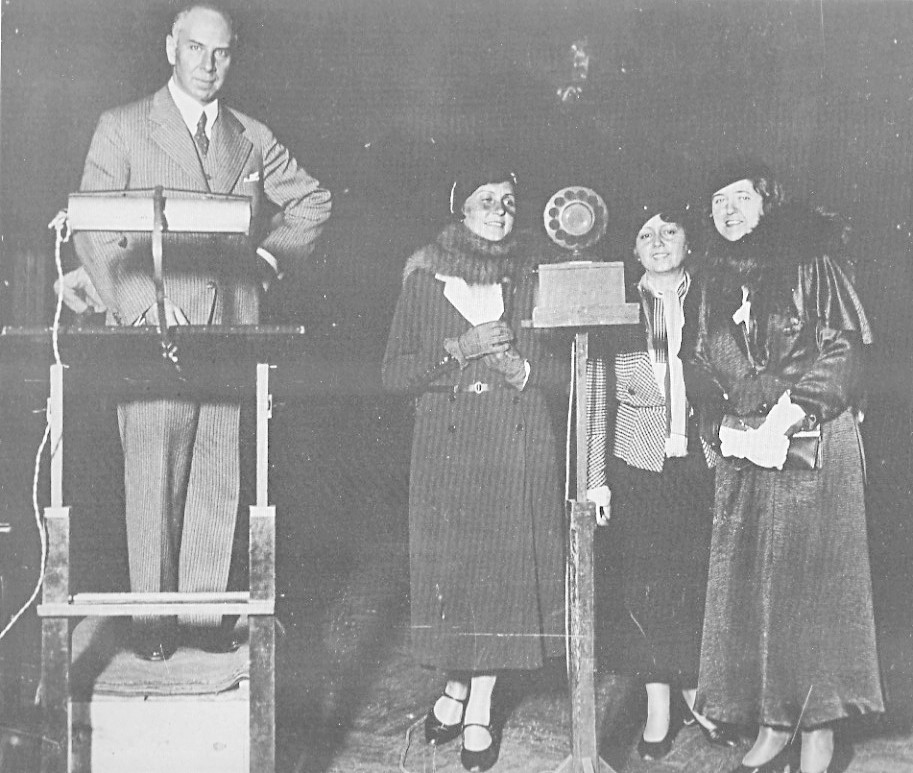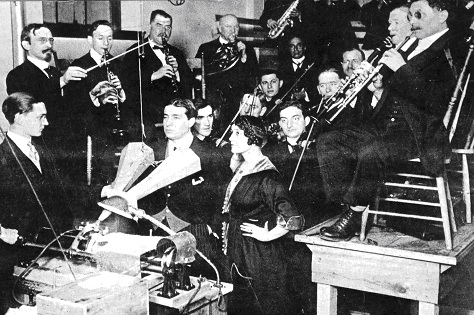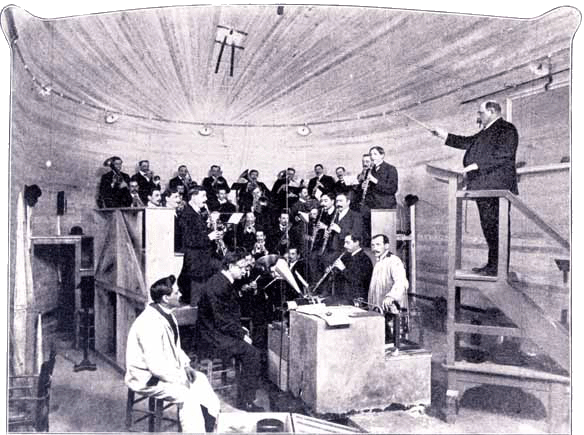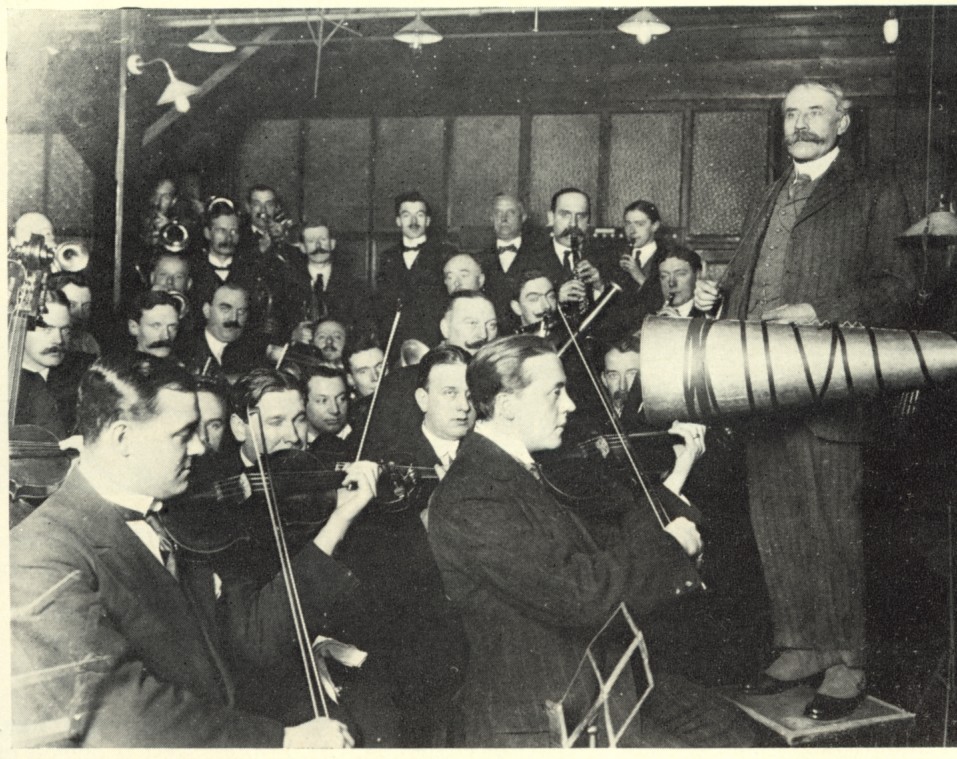
The 1933 Rosenkavalier recording team: Heger, Olszewska, Schumann, and Lehmann.
This chapter will introduce you to early recording techniques in a general way and, more specifically, how they related to Lehmann recordings.
The first demonstration of disc recording and reproduction occurred in 1888, the year of Lehmann’s birth. The cylinders that Edison invented had been demonstrated as far back as 1877, but since Lehmann never recorded for a cylinder as a consumer product, we’ll concentrate on discs.
Lehmann made her first recordings in 1914. To give you an idea of how early in the history of recorded sound that is, the first singer of international fame to record on disc was Clara Butt in 1899. Caruso, whose Victor recordings almost made the recording industry, sang his first recordings in 1903.
Acoustic Recording

How a duet was recorded
In 1914, the year of Lehmann’s first recording, the process was still fairly primitive, but as the years went by the resulting sound was improved through the use of many technical advances. This was the “acoustic” process: no electric microphone was used. Instead there was a horn made of wood or metal (later stiffened fabric) that concentrated the vibrations of the singer and accompaniment down to the point of a needle which etched them into warm wax. There was no such thing as “splicing” a tape; if something went very wrong another “take” was required. The whole aria or song was recorded again. Some performers needed many takes; Lehmann seldom went beyond three, and usually the first or second performance sufficed.

Pathé Orchestra at Pathé Frères.
Though Lehmann’s first recordings, for Pathé, were issued on discs, the master was a cylinder. The sound from this cylinder was later transferred to disc. These first recordings had no paper label, but rather were etched with the information: “Lotte Lehmann, Stadttheater Hamburg.” Instead of the needle starting from the outer edge, these discs began in the center and moved outward. Since the climax of an aria or song occurs at the end, this offers an advantage. The outer grooves offered more space for these vibrations and were moving at a faster speed, producing greater fidelity. Why this was discontinued is a mystery. The rotating speed (revolutions per minute or rpm) for Lehmann’s first discs was probably about 87!
We often hear the term “78s” when referring to early (pre-LP) recordings, but there was a great variance in the speed. If care isn’t taken when playing or transferring early recordings, the incorrect speed can change not only the pitch of the music, but the tonal quality of the singer. To add to the confusion, a label might state 78rpm but have been recorded at 74rpm or even 72rpm. When played at 78rpm the result can be as much as a semitone higher! The correct “pitching” of an early disc is made more complicated by the lack of a true international tuning “A,” which can still be a problem. Further, the artist might not have performed the piece in the original key. This was especially true for Lehmann at the end of her performing and recording career, when it was common for her to sing in a lower key.
Another aspect of early recordings that must be considered when listening to them, is the limit in frequency range (both upper and lower) that could strip a singer of the richness of overtones (harmonics). The resulting sound can be “pure” or dull, depending on your perspective. Some singers, famous on the opera and concert stage, did not sound as good in the studio. Lehmann’s voice, however, recorded well. Horst Wahl has written an account (below) of a Lehmann recording made at the end of the acoustic era.
Acoustic recording did not preserve sibilants well and voiceless consonants (t and k) are difficult to identify. When listening to an acoustic recording of an unfamiliar song or aria, it’s helpful to have the words or sheet music handy to help identify the words. On another technical matter, let me quote John Steane from his book, The Grand Tradition (1974). “Wear on the matrix is…insidious; the matrices of popular recordings deteriorated.” The matrix printed the “mothers” which printed the stampers, which in turn printed the consumer discs; the result of an overused, worn matrix was distorted reproduction. Further, inferior materials, such as the shellac used for the final product, forced the voice “to fight its way through a turgid hiss of surface noise that all but overwhelms it” (Steane).
In addition, the recording horn had its own acoustic properties, its own reverberation, which compounded those of the singer. Thomas Stockham, Jr., an acoustician writes, “the most serious defect is the resonant and reverberant quality given to the voice and musical instruments by the primitive recording horns used to focus the sound onto the original wax discs.…Offensive loud bursts of sound also occur when certain tones are played or sung.” Imagine blowing across a bottle—it has a pitch. Likewise, the horn had its own pitch and when that and the pitch of the singer or instrumentalist met, this “sympathetic vibration” caused a kind of explosion of distortion.
The orchestras used for these early recordings were often banked on bleachers around the recording horn. 
The double bass (whose sound made the cutting stylus bounce) was replaced by the tuba, and the violins had amplifying horns built into their instruments. These strange-looking contraptions were called “Stroh” violins, after their inventor.
The singer had to take care to sing into the very center of the horn. Lehmann remembered the producers making chalk marks on the floor, put there to remind her where she should stand at particular moments of the aria or song. To avoid distortion, or the needle jumping, she needed to retreat from the horn on certain notes or the loudest ones. Lehmann referred to this as “more dancing than singing.” The result is that climaxes were altered because of this concern that the cutting needle might jump out of the groove or even break through to another groove. In spite of these limitations, we now marvel at the ability of the artists to concentrate on singing as they moved about and dealt with the other technical considerations.
Another artistic restriction was the limited length of a single take. There must have always been pressure to finish an aria or song within the four minutes available on a disc. This led to cuts being made or just a faster tempo employed. For a short song, an introduction might be composed. A famous critic of the time, Herman Klein, wrote of a recording where the contrast between the cavatina and faster cabaletta was spoiled. “The object of this was, I imagine, to bring the whole piece within the necessary time-limit, but that is no excuse for spoiling the music. It is infinitely better to make a liberal ‘cut’ than alter the character of the piece.” One can see that few good choices were available.
The few Lieder recordings that Lehmann made before the microphone was employed used orchestra or added violin to the piano accompaniment originally intended by the composer. The result isn’t as annoying to our ears as the salon orchestras that accompanied her later electric song records. Morgen
Even with surface noise and sonic limitations, there is still much beauty to be enjoyed from acoustic recordings. Our ears quickly adjust to the limits and learn to filter out the surface noise and other distortions. Our appreciation for the historic moment is great. We’re able to hear someone like Lehmann at the very beginning of her career, and we can hear singing traditions and styles of that period. The chance to compare Lehmann in her early and later interpretations of the same aria or song is another blessing of these acoustic recordings. Du Ärmste [Missing Later Recording]
It’s interesting to note the controversy caused by the introduction of the microphone. It didn’t seem to offer the pure acoustic of the singer’s vibrations etched into the disc. The advantages in dynamic range (loud/soft), clear diction for singers (this is where Lehmann had a huge advantage) and finally, a more accurate recording of the sound, weren’t immediately obvious.
Electric Recording
 “Electric” recording emerged about 1925. It refers to the use of a microphone, the turntable having already been turned by an electric motor. Odeon was Lehmann’s recording company at the time. Because of patent restrictions on the microphone, Odeon was late taking up this new invention. By August 1926, when Lehmann recorded the Rosenlieder cycle (see below), they finally were able to use a microphone. But Lehmann was unhappy with the result, which to her sounded metallic and tinny. There was, however, an alternative: the recording engineer Horst Wahl, had invented a new recording method using a larger horn with tape around it, which was, of course, the old acoustic method. Lehmann recorded the whole set of songs again. Even though a horn was used instead of a microphone, it was, to Lehmann and Wahl, a better sound and it was this set that was published. To keep up with the competition, the catalog and the record label listed this as an electric recording, but in fact it was still acoustic. Here is a portion of one of the recordings from that set that was actually acoustic. Listen to the warmth of the sound and the fact that you can actually hear the hard consonants. Wahl had indeed really refined the acoustic horn to that degree. Weisse Und Rote Rose
“Electric” recording emerged about 1925. It refers to the use of a microphone, the turntable having already been turned by an electric motor. Odeon was Lehmann’s recording company at the time. Because of patent restrictions on the microphone, Odeon was late taking up this new invention. By August 1926, when Lehmann recorded the Rosenlieder cycle (see below), they finally were able to use a microphone. But Lehmann was unhappy with the result, which to her sounded metallic and tinny. There was, however, an alternative: the recording engineer Horst Wahl, had invented a new recording method using a larger horn with tape around it, which was, of course, the old acoustic method. Lehmann recorded the whole set of songs again. Even though a horn was used instead of a microphone, it was, to Lehmann and Wahl, a better sound and it was this set that was published. To keep up with the competition, the catalog and the record label listed this as an electric recording, but in fact it was still acoustic. Here is a portion of one of the recordings from that set that was actually acoustic. Listen to the warmth of the sound and the fact that you can actually hear the hard consonants. Wahl had indeed really refined the acoustic horn to that degree. Weisse Und Rote Rose
By February of 1927 Odeon was exclusively using the microphone and the resulting sound had vastly improved. Sei mir gegrüsst
Finally the words, with all the enunciation for which Lehmann was famous, were able to be heard. Sadly, all the defects of the accompanying orchestras were also apparent! It is hard to believe that members of the Berlin State Opera Orchestra played so out of tune! Of course it wasn’t the whole ensemble, the conductors weren’t always first rate, there was no rehearsal time allowed, and the acoustics of the recording studios were primitive. But the poor intonation of the strings makes for distracting listening to many of these recordings and especially to an otherwise admirable recording that Lehmann made of Schubert’s “An die Musik” in 1927. An die Musik
This is only one example in which the accompaniment is bothersome to the listener many years removed from the original recording. The obvious indifference to intonation included the piano which was often un-tuned. It has been suggested that improper playback speeds and other technical matters might account for these intonation problems. If this were the case, why does Lehmann always sound in tune?
Earlier I mentioned that art songs were orchestrated for early recordings—record companies assumed that their listening (buying) public might feel cheated with just the original piano accompaniment. Thus, the café orchestra, the salon orchestra, or the instrumental trio often accompanied Lehmann’s early Lieder recordings. The in-house arrangers took liberties to “improve” on the harmonies of such masters as Schubert and Schumann. Added inner lines and extended introductions were often part of the process. Unintended intonation problems exacerbated things.7 – 7. An Meinem Herzen, An Meiner Brust
One of the limitations of recording after 1927 was the use of just one microphone. Whether recording a singer with a Wagnerian orchestra or a piano, the microphone was placed near the singer, with the result that the accompaniment was never at the dynamic level we expect in a concert hall or opera house.
The same limitations of about four minutes per record still obtained for electric recordings. In 1930 when Lehmann recorded her first “Erlkönig,” there was a rush to fit it all on one 10-inch disc when a 12-inch disc was really needed. The pianist couldn’t manage the triplets, Lehmann’s interpretation sounds hurried, and the result is very disappointing, even comical, especially when compared to her later efforts. 21 Der Erlkonig RadioErlkönig
During the electric recording era, there was still both frequency and amplitude loss, though not to the same extent as with acoustic recordings. When Lehmann (or others) sang a loud climax, the engineers turned down the volume to avoid distorting. They sometimes overdid this, short-changing us some wonderful moments, but they were doing the best they could within the technology available at the time.
When I interviewed Lehmann by telephone in her 85th year, I asked about the rehearsal for a recording of the now-classic Die Walküre with Bruno Walter conducting. Was there a lot of preparation, rehearsal and such? “Ach no, Gary. We knew it already!” was the response. And this was not unusual. For some reason there was a very casual attitude towards recording. It was seen as a “commercial” rather than an “artistic” endeavor. Lehmann herself remembers joking with her close friend Elisabeth Schumann that they made some recordings this month “for a little extra mad money.”
Sometimes when the 78s were transferred to LPs, it was thought necessary to “improve” the sound with an echo chamber (resonance) effect. Also the effort to eliminate the hiss of the surface noise could wipe out the high harmonics of the voice. With CDs the problem of surface noise is often well handled, but there are those who hear a great loss in the harmonics and overtones that give a voice character.
Almost all of the arias that Lehmann recorded are in German, whether the original was in French, Italian, or Russian. This seems strange to us now, especially with surtitles available in most American opera houses, but in Germany and Austria, audience members expected to hear the opera in their own language, such as this Butterfly recording. Entrance of Butterfly 07 Entrance Of Butterfly
This carried over into recordings and Lehmann (and others) sang French roles in German even in Paris! To be fair, the French singers sang the German roles in French. So we have the almost comical confluence of a great singer such as Lehmann performing a Wagnerian opera in Paris, in which she was the only one singing the original language.
Lehmann’s Recording of Rosenlieder
Correspondence with the author by Horst Wahl
To my great joy I have discovered that some of my earliest professional recordings, produced more than 64 years ago for the Odeon recording firm, have just been resurrected on a compact disk. Lotte Lehmann’s interpretation of the Rosenlieder of Count Philipp zu Eulenburg [and Werner’s song] are on Pearl GEMM CD 9409.
Eulenburg (1847-1921) belonged to Kaiser Wilhelm II’s closest circle of friends and was elevated to the rank of prince in 1900. His hobby was the composition of songs in the folk tradition, and his Rosenlieder cycle enjoyed great popularity in the period just before the first World War. As it did not present great difficulties in its vocal, piano or violin parts, it was often quite satisfactorily performed during evening soirées by music-loving amateurs.
At the time the Rosenlieder recordings were made, on 5 August 1926, I was still quite a young man and had been employed a year and a half on the retail sales staff of Odeon. My acquaintance with Lotte Lehmann began in May of 1925 when the artist entered our retail outlet on Leipziger Street in Berlin one day to listen to a few new recordings of prominent sopranos. Although I was, of course, quite familiar with her appearance in photographs and on the Berlin Opera House stage, I did not immediately recognize her as she was wearing the latest rage in women’s hats of the period. It was rather a pot-like affair and covered her face down to the eyes. When she asked me which sopranos I would especially recommend, I replied with cool placidity and the deepest certainty, “Well, if you ask my opinion, madam, there is only one—Lotte Lehmann. She is the greatest of them all.”
You can well imagine how such a young coxcomb as I might have felt when from under the stylish helmet came the vigorous reply, “Thank you, young man, that is who I am.”
There have been few times in my life as perplexed and confused as those moments. I might as well have been struck by lightning. From this moment on began a deep friendship [and more…] which lasted for ten years and which belongs to the most wonderful experiences of my long life.
I had at that time a sound studio in Berlin on Augsburger St., where for three years I had produced for the private use of my customers, acoustic recordings on zinc, acetate or other synthetic materials. Among my clients were such important singers as Joseph Schwarz, my neighbor; Meta Seinemeyer, Sabine Meyen, Hedwig Francillo-Kauffmann, Margarethe Matzenauer, Michael Bohnen and Alexander Kirchner.
When I mentioned this sideline occupation to Lotte one day, she immediately decided to test her voice on my equipment. Among the test recordings were duets which we sang together, (I had studied voice with Prof. Bernhard Ulrich), among them the Rosenlieder of which we were both especially fond.
As we listened to these recordings, the sound of her voice and also of the accompanying piano was so remarkably natural sounding by acoustic recording standards of the day, that she asked me if this lieder cycle might not be commercially produced by Odeon.
At that very time, a major technological change was rolling through all recording firms: electric recording. Odeon had already taken its first steps in this direction, and it appeared as if the Rosenlieder with its simple piano and violin accompaniment would be an ideal test.
During the first electric recording session with Lehmann on 2 August 1926, I was otherwise employed and not at hand. Three days later we (Lotte, Dajos Bela, Mischa Spoliansky, Georg von Wysocki, Odeon artistic director, and myself) listened to the sample recordings.
It was sadly obvious to all of us that the electric microphone had not done justice to either Lotte’s wonderful voice or Dajos Bela’s lovely violin. Both came over the loudspeaker with much too sharp a sound.
After a conference with the management of the firm, Lotte was able to get permission for me to record these songs acoustically, using my own methods. To this end I then brought to the Odeon studio my own large horns, one for the singer and one for both accompanists.
Whereas the Odeon “Trichter” [horns] were made of cloth, the horns I had made for myself were of metal wound with insulating tape to prevent self-vibration. The larger diameter of these horns allowed the singer to come so near the device that occasionally her head would project into it. Happily for me, the calm and not overly tempestuous nature of the music worked all to the good, and most of the danger of “blasting” was avoided.
Lotte Lehmann signed the release for publication of the Rosenlieder on 14 December 1926. This lieder cycle was first offered to the public in March of 1927 under the errant nomenclature “Electric Odeon Recording,” and in succeeding years, due to its high quality, it continued to be listed in all the catalogs as “electrically recorded.”
Mischa Spoliansky, like Lotte Lehmann, lived a long life, and even in his late 80s appeared on German television recounting incidents of his artistic life.
In these songs Lotte quite consciously used a short and frequent taking of breath as a medium for musical expression, evoking her passionate presence. Instead of the higher range usually found in her other recordings, her voice moved here within a quite enchanting mezzo range.
If I allow a little self-praise here, the reproduction of the original Rosenlieder belongs to the best of acoustic recordings and is nearly impossible to distinguish from early electrics. Voice and accompaniment are both well balanced. The clearly audible breath brings the singer to vivid life before us. The current reissue on compact disk presents the first publication of the Rosenlieder since they were issued on 78rpm shellacs.
(From personal correspondence between the author and Horst Wahl.)
You may want to return to the first page discussing electric recordings and sample one of the Rosenlieder again.
